How to make the best French toast like in our bakeries or restaurants in France. Easy Pain Perdu recipe, how it's served in France with plenty topping ideas and tips. With many thanks to our local boulangerie in Saint-Germain-en-Laye near Paris for sharing their authentic recipe.
Best French toast, ever! Thank you from USA! - Elaine
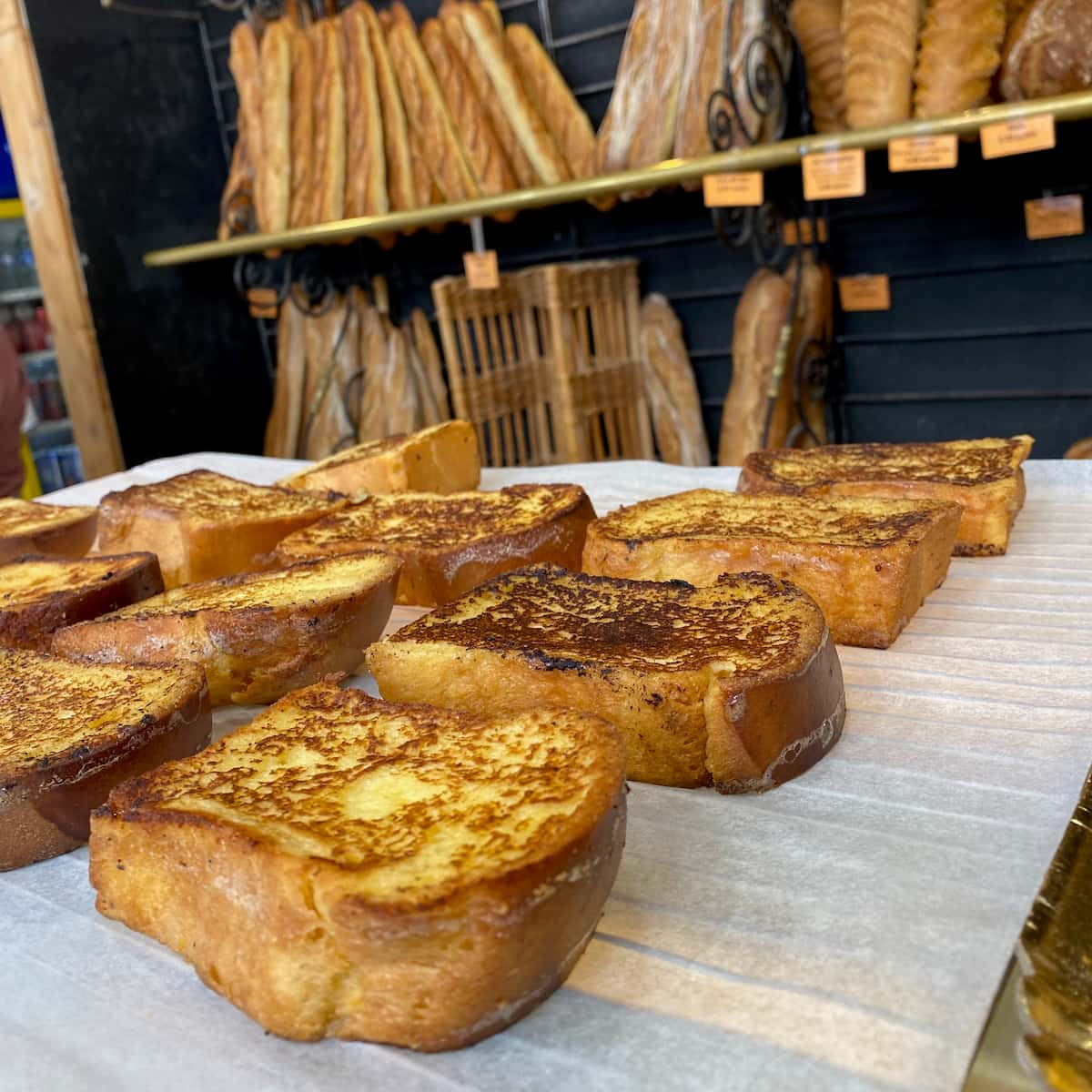
What is the French Version of French Toast?
While French toast is usually served for breakfast or brunch in America, plus eggy bread in the UK - in France it is usually served for dessert. It's often seen on dessert menus around Paris in brasseries and bistros.
So, how do you order the French version of French toast or recognise it on the menu? It's simply known in French as pain perdu (pronounced 'pang pear-doo'.)
As it's seen as a dessert, this explains why certain smaller French hotels are unlikely to have it on their breakfast menu.
Why is it Called Pain Perdu?
The meaning for Pain Perdu is literally translated as 'lost bread' in English.
'Lost Bread' refers to the time-old method of reviving fresh bread that has gone slightly stale a day or two later. So not to be lost, it's an easy recipe that has been around for centuries - since at least the Romans in the 1st century - in the combat of avoiding food waste.
Not only is fresh French bread central to our culture here from our boulangeries or bakeries, it is the utmost priority to save good bread from being lost or wasted.
Did French Toast Originate in France?
Before the French name, pain perdu was used in France between the 14th-15th century, it actually originated from the Romans.
The Roman author, Marcus Gavius Apicius (approx. -25 BC to 37 AC), first mentions a recipe ('De re coquinaria', meaning 'Culinary Art') using the same ingredients of using up old bread dipped in milk and honey then fried in oil.
So French toast was known as 'pain romain' in France, meaning Roman bread. It wasn't until the 17th century that the sweet recipe version of French toast arrived as we know it better today.
Henry IV, who was French king (1589-1610) was a particular fan of Pain Perdu. He brought the original basic dish for the poor to use up old bread into something a bit more aristocratic in France.
See the fun facts below for much more on French toast.
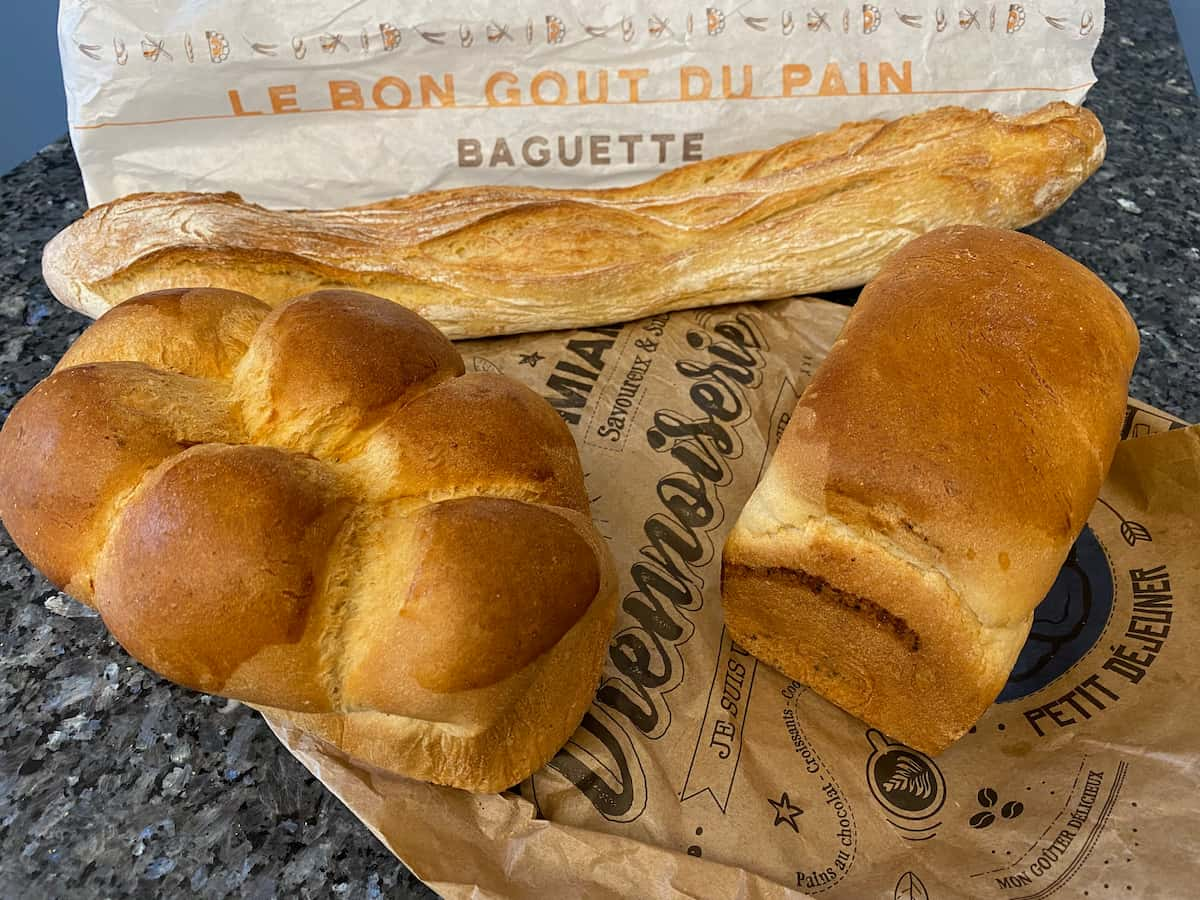
Best Kind of Bread to Use for Pain Perdu
While using a day-old baguette is good at home, it's not the kind of bread that's used in bakeries and restaurants serving pain perdu in France. For example, Laurent, our baker, uses any unsold baguette sticks at the end of the day not for this recipe but for a charity association.
Instead he uses more fluffy white bread like pain de mie, which is unsliced bread for slicing. The closest is brioche and are both the best kinds to use, as so much lighter. So, if yours is not fluffy, it's probably down to the kind of bread you're using.
As a result, if you want the best authentic French toast made like the French in restaurants or boulangeries, use an unsliced bread that's white, light and fluffy.
Any of the following are good:
- White bread (pain de mie) meant for slicing
- Brioche
- Challah
- Pain au lait
- Boule, large and round white bread loaf
Most popular these days, the best to use is pain brioché - get my fluffy brioche recipe to make your own. This is the global closest equivalent to the pain de mie.
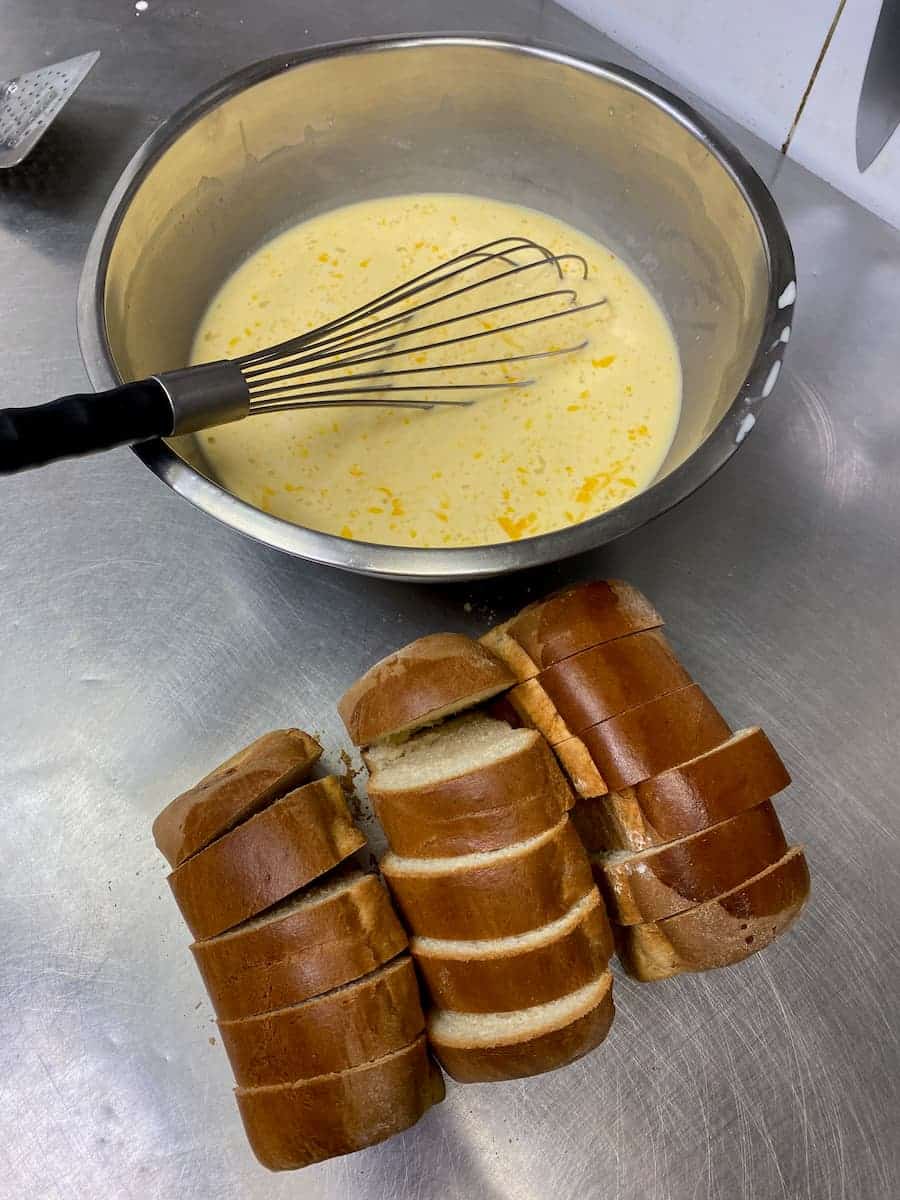
What is the Trick to Making the Best French Toast?
Here are our easy recipe tips to making the best French Toast or Pain Perdu like in France. By following these tricks, you'll avoid making the most common mistakes in making it:
- Quality ingredients. The better the bread, the better the toast - and it will be fluffy.
To make the most authentic pain perdu from our boulangerie or French bakery, avoid using processed ready-sliced bread in packets. Unsliced, old 'fresh' bread is best (1-2 days' old). If you can't find this, the best and nearest option is brioche; - Measure out your ingredients using a scale. It sounds complex but it's not. It makes a huge difference!
- Slice bread into thick slices. Cut to 2-3cm (an inch) thickness.
If sliced too thin, they fall apart; - Add milk to bind the eggs. Should French toast have more eggs or milk?
Although a main ingredient, eggs need the equivalent liquid quantity of milk to make it light. If it's mainly eggs (as often misleading in the name, 'Eggy Bread') without the milk, then it's like a stodgy omelette bread; - The bread should be totally soaked in the eggy milk.
A few seconds is all it takes, depending on how dry the bread is. (Unless your bread is really too hard - otherwise please don't use it. Make croutons instead!) Test it is soaked enough by squeezing the sides of the bread (seen on upcoming video); - Beurre Noisette: Use butter, not oil and in a non-stick pan.
Browning the butter as it cooks is what gives its naturally nutty, toasted flavour to the bread. It adds a slightly crunchy texture to the outside, while the inside remains soft and slightly spongy; - Serve warm: avoid them turning cold while making them.
Keep toasted slices in a warm oven (100°C fan/120°C) or reheat for a few seconds in the microwave.
In a nutshell, the slices should not be too thin and cooked in enough good quality butter to give them that toasted, nutty flavour.
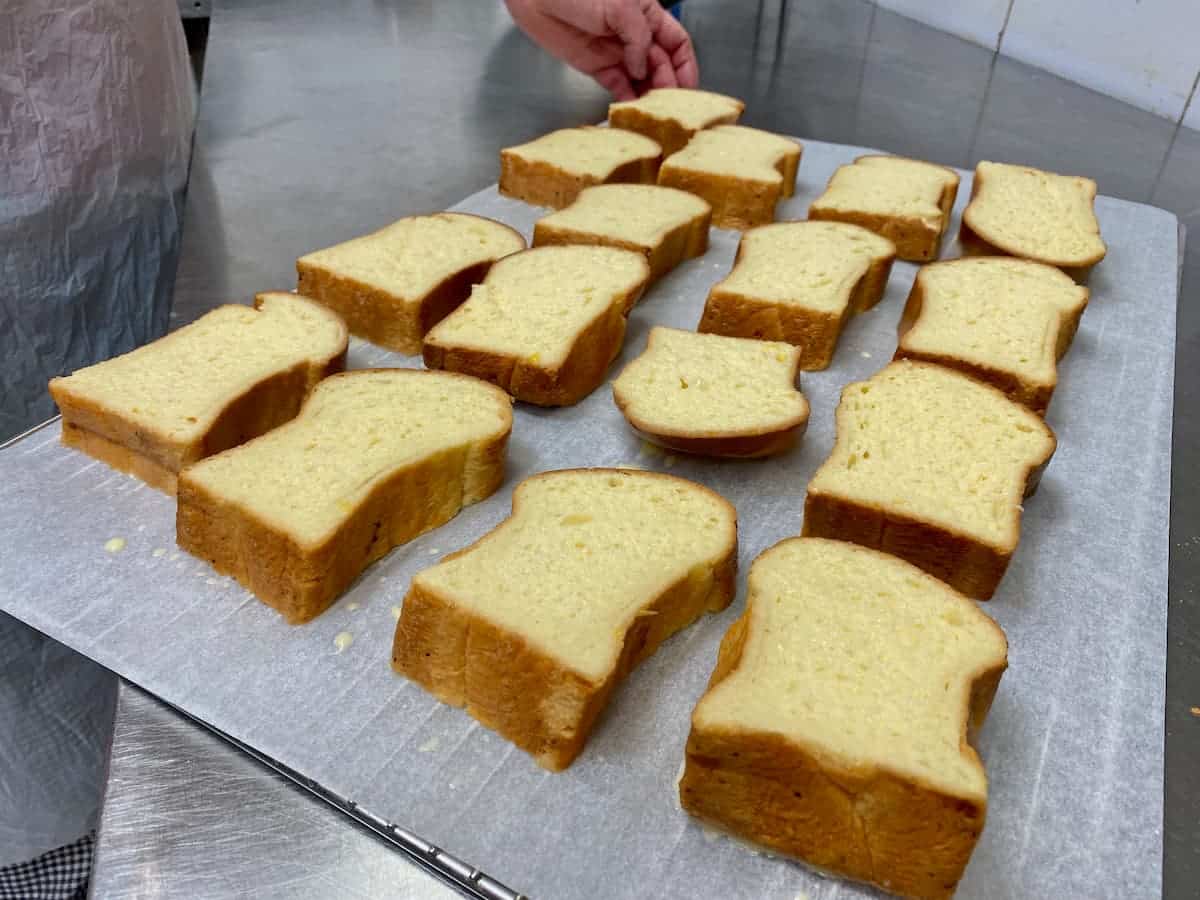
Fun Facts about French Toast
There are many fun facts I've found associated with French Toast. However, it's not clear how genuine each of them are, hence the word, fun.
So here are the main ones with the following sources ('On va déguster France' by François-Régis Gaudry; Larousse Gastronomique; Wikipedia; Europe 1 French documentary 'Historiquement Vôtre' by Olivier Poels; and Escoffier's Le Guide Culinaire):
- It was known as pain crotté or pain à la romaine (Roman bread). Said to exist from the Romans in the 1st century BC, it first appeared in a cookbook by Marcus Apicius.
- According to Olivier Poels, it was called 'French Bread' in England - with 'French' meaning 'sliced' in old Irish, rather than French - although I can't find any other source for this.
- According to popular legend, perhaps it should have been called French's toast.
In 1724, New York tavern owner, Joseph French, came up with the idea of re-cycling leftover bread. - In New Orleans, it's only known as pain perdu, while around the world it has other names:
e.g. UK Eggy Bread, Portuguese and Brazilian Rabanadas, Danish, Norwegian and German Arme Riddere/Ritter (Poor Knights), and Indian Bombay Toast; - According to Chef Auguste Escoffier, he calls it pain perdu but also Croûte Dorée, meaning golden crust.
- In the south of France, it was served during religious festivals, notably at Easter.
- In Alsace, there's a savoury variation called Brotknepfle. Formed into quenelle shapes with shallots and nutmeg.
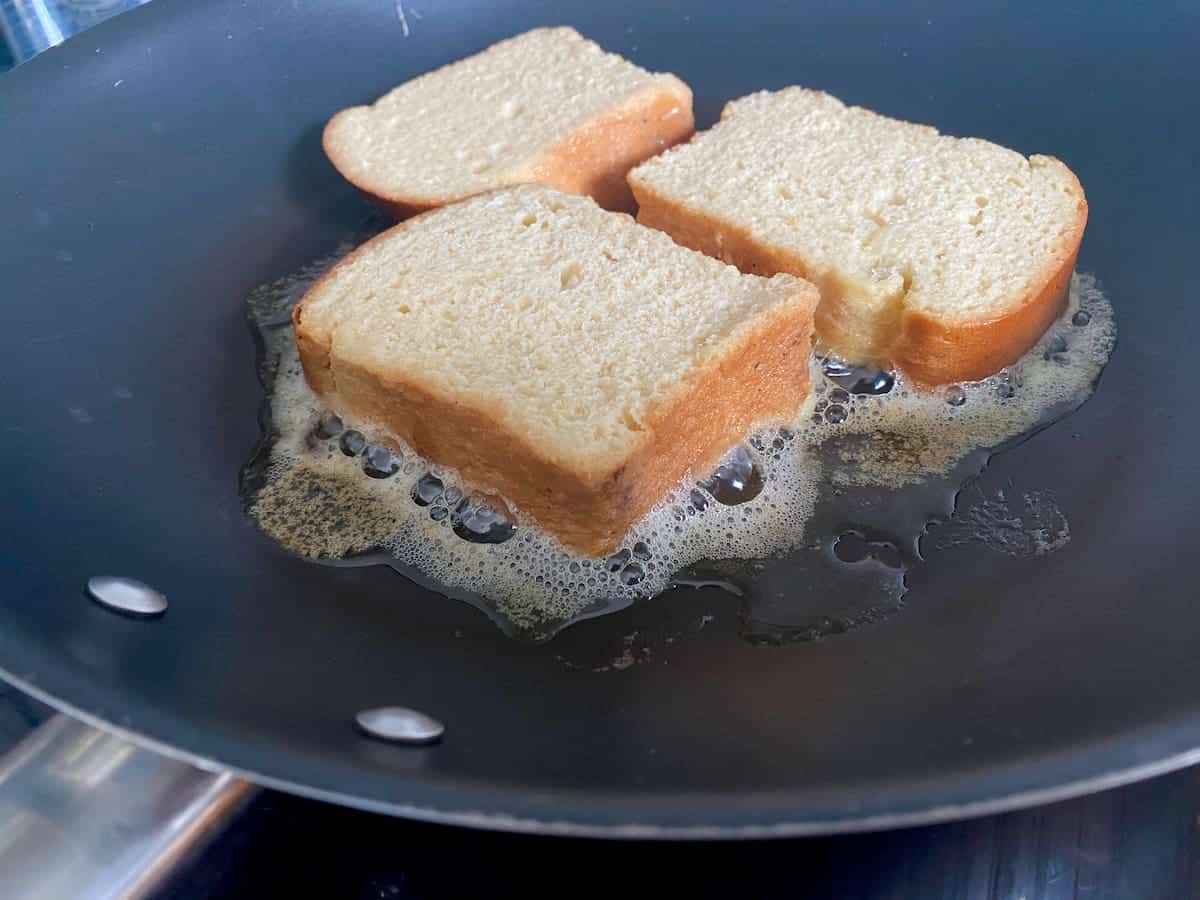
Variations of Pain Perdu
While this recipe is the most classic and the one used in our local bakery (boulangerie), chefs also add a personalised touch. Laurent adds a little unrefined raw brown cane sugar (sucre de canne/roux, 'Cassonade'), which gives a little caramel and vanilla flavour to the batter. I explain granulated brown sugar on the FAQ page.
Chefs also add ingredients such as:
- Vanilla: ideally scraped seeds from a vanilla pod (or bean), or 1 teaspoon of powder or extract.
- More heavy cream.
- Different liqueurs depending on French region: Armagnac, Calvados (or Pommeau), Cointreau, Rum.
Is it Healthy?
This pain perdu recipe is healthy, as it is low in sugar and uses a little butter. Don't forget that butter isn't bad for you - as long as it's consumed with moderation and is good quality butter (French style at 82% - see US/UK glossary of French ingredients).
However, much like with French pancakes or crêpes, it's the toppings that can end up making this unhealthy. Especially if the products are ultra-processed: such as synthetic cream, ice cream and synthetic chocolate spreads.
As a result, I strongly urge you to use the most natural toppings as much as possible and avoid industrialised packaged foods which mostly contain far too much sugar.
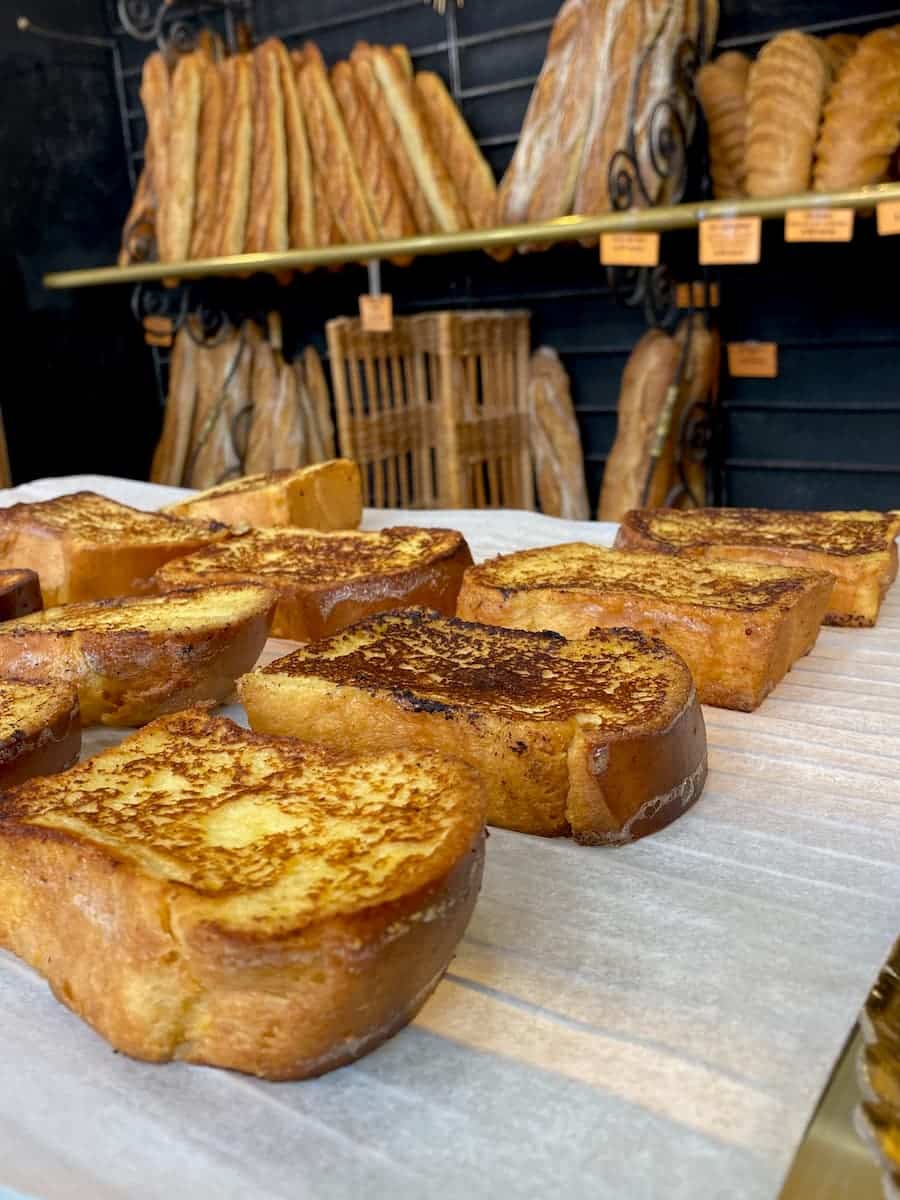
What are Good Toppings for French Toast at Breakfast?
Slices are delicious served simply on their own, just like pain perdu is sold in our bakeries in France.
Add the following healthy toppings, according to season and mood to make the ultimate breakfast or brunch:
- A light dusting of icing/confectioner's sugar and/or ground cinnamon;
- A squeeze of lemon or lime or orange slices;
- A drizzle of runny honey - (see my article on how to tell if it's pure honey)
- Maple syrup;
- Fresh berries: strawberries, raspberries, blueberries;
- Exotic fruits: passion fruit, kiwis, sliced mango or pineapple;
- Confitures or jams - such as apricot jam, rhubarb jam, Corsican fig jam and spiced plum jam;
- Orange curd;
- Apple compote.

Best Pain Perdu Topping Ideas for Dessert - Like the French
If serving pain perdu slices as a dessert like in France, enjoy them served warm with either fresh seasonal fruits, roasted fruits or sauces from my following accompanying recipes. Some of my top 10 sweet topping ideas are inspired by the desserts from Ladurée in Paris:
- Roasted sticky pineapple with vanilla;
- Baked apricots - add a little lavender for an extra French touch;
- Roasted plums - add either vanilla or spice them up with a little cinnamon;
- Roasted figs in port;
- Rhubarb compote - Served with rhubarb and strawberry compote at Ladurée, make this compote recipe with strawberries. Make a batch or two of the compote and freeze to enjoy this out of season;
- Salted caramel sauce - drizzle it on! How it's also served at Ladurée;
- Apples Normandy style - serve with a few fried apples in a little butter and flambé with Calvados (apple liqueur);
- Crème anglaise - this classic custard sauce recipe is infused with Chai tea (which also would be a unique way to serve this) but can be made traditionally plain with vanilla;
- Rhubarb and Rose Sorbet - perfect for summer, make an Ispahan style with rose as a refreshing dessert;
- Chestnut & Vanilla Ice Cream - Often served with vanilla ice cream, or almond ice cream at Ladurée, be unique and serve with this delicious creamy glace aux marrons.
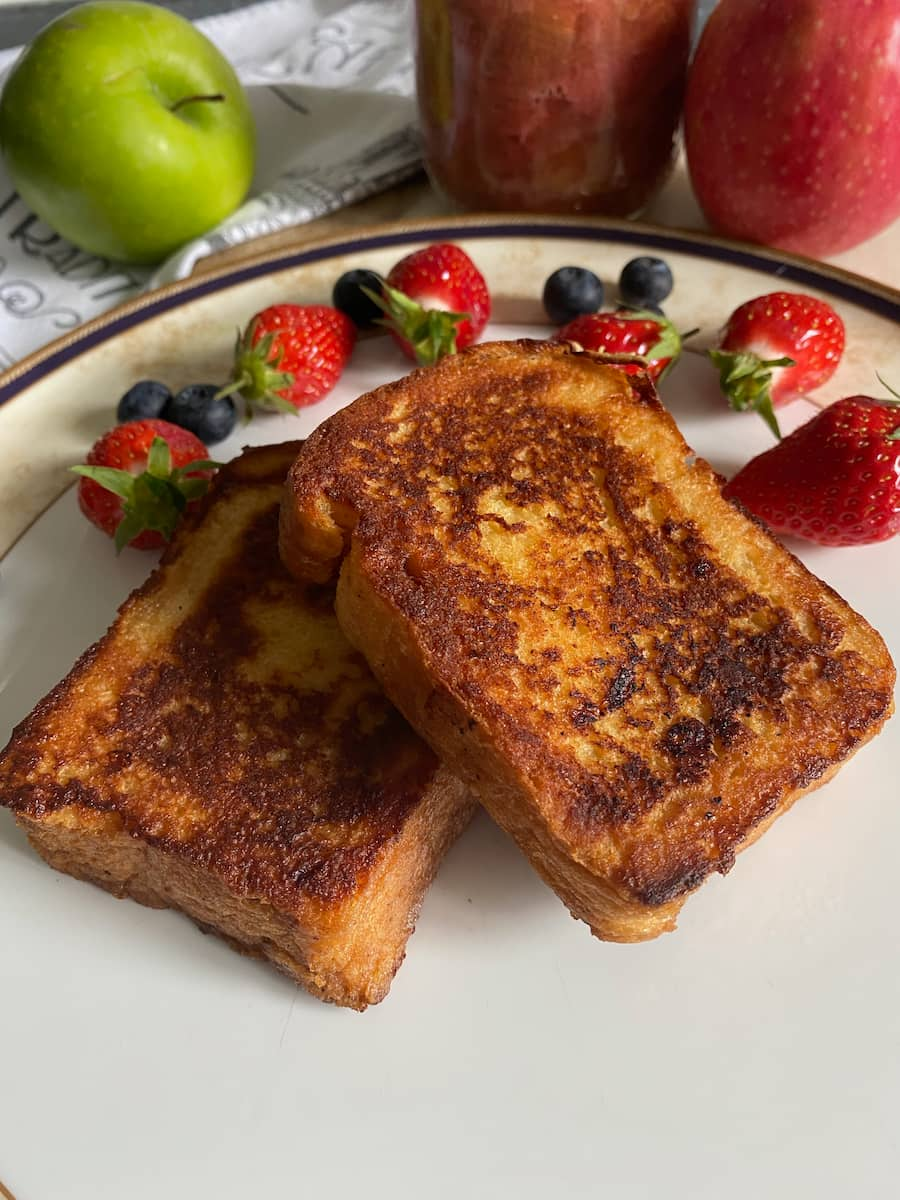
With huge thanks to Laurent Ehmig for welcoming us into his boulangerie, l'Aigle d'Or in Saint-Germain-en-Laye near Paris. As you can see from his easy recipe, he has shared all his tips so you can make French toast just like the French.
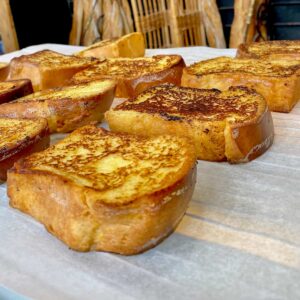
Best French Toast Recipe (Pain Perdu)
Ingredients
- loaf of day-old white bread or brioche (unsliced)
- 3 (150g) eggs organic
- 200 ml (¾ cup) whole milk or semi-skimmed
- 50 ml (bit less than ¼ cup) heavy cream (crème liquide)
- 50 g (¼ cup) sugar
- 25 g (2 tbsp) brown cane sugar (unrefined, granulated, crystallised sugar) See NOTES
- pinch sea salt fleur de sel, Maldon or Celtic
- 25 g (2 tbsp) butter unsalted
Instructions
- In a large bowl, whisk together the eggs, sugar and cane sugar. Pour in the milk and cream.
- Cut the bread or brioche into about 6 thick slices of about 2-3cm (an inch) per slice.
- Soak each slice in the liquid for a few seconds (or more if the bread is quite dry) until completely soaked through the bread. Transfer each slice to a tray.
- In a medium-hot non-stick frying pan, melt the butter until it starts to mousse a little.
- Fry the slices in the butter until well toasted on each side. As the slices cook, the butter will also become toasted. Repeat until all the slices are used.

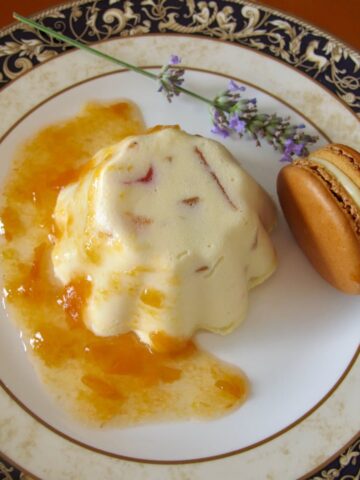
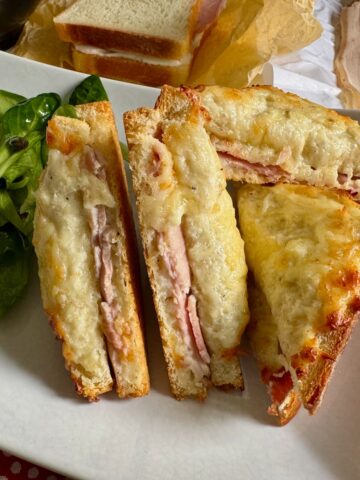
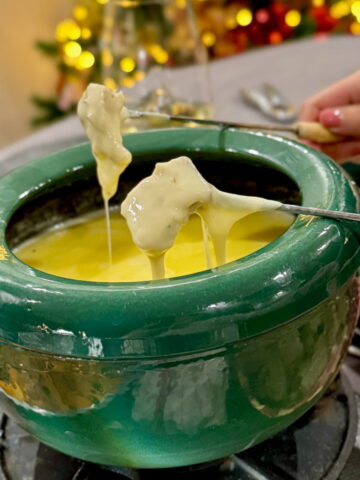
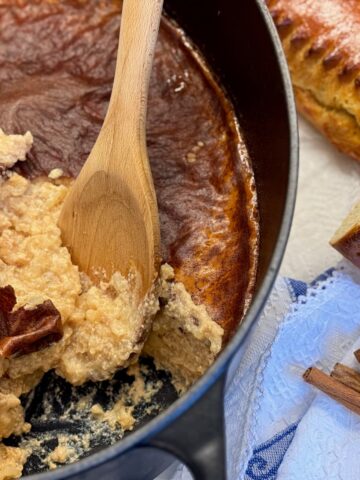

HT
You have always been my go to mentor. Years ago my life change with your (now my) Pain Perdu recipe.
Also many thanks for all the product testing, I now have only the best in my arsenal thanks to you!
Jill Colonna
Thanks so much for your lovely words on my Youtube video! I'm sorry but I didn't get your name but so happy to hear - and Laurent will be too!
June Stobie
I love this French Toast with strawberries. I didn’t know that you could keep some in the freezer.
Jill Colonna
So happy you like it! Yes, it's handy to freeze if you do have any unlikely leftovers!
June S
Love this recipe and love the video.
Jill Colonna
Thanks so much for popping in to say so! Happy, too, you like the video as I put a lot of work into it.
D
In the recipe "sugar" is regular white sugar, is "cane sugar" brown sugar? If brown sugar is it light or dark brown sugar?
Jill Colonna
Thanks for asking, as I'll update the recipe to make it clear. In the video, Laurent refers to it as cane sugar (sucre roux), which is also 'Cassonade' in French. This is natural raw brown cane sugar. It's a hard, unrefined, crystallised sugar, which is light, free-flowing and granulated so doesn't clump together. It adds a slight rum, vanilla and caramel flavour to your recipes like French toast. Although related, it's not the same as soft brown sugar which is darker. I've updated the FAQ page, so hope this helps.
Tony
Enjoyed this at the weekend. We love that it’s not too sweet and very light. Definitely making this again as family loved it!
Jill Colonna
So glad to hear you and your family liked this, Tony. Thanks for taking the time to comment.
Caroline Gilbert
This looks absolutely delicious - love the thick slices, though I must admit, I think I would go one step further, be super indulgent and add maple syrup. Yum
Jill Colonna
And why not? Enjoy it, Caroline. Glad you like it.
Saoirse
Hello from Ireland Jill,
So happy to have found your blog. Looking forward to making some of your wonderful recipes for my French husband.
Cheers to you and yours, Saoirse
Jill Colonna
So happy to virtually meet you, Saoirse and look forward to your French husband tasting the recipes with you! Slainte J x
Fran@Gday Souffle
Thanks for all this information. We Americans, would of course, top our French Toast (Pain perdu) with some maple syrup. I love the thick cut of the bread!
Jill Colonna
It's a pleasure, Fran - I hope you try this recipe!
Geni Mermoud
What a great recipe!! The French toast turned out perfectly. The addition of brown sugar makes all the difference!
Thank you Jill and Laurent. I made this recipe this weekend and it was delish! The toast browned up nicely and was just like you said - crispy outside and tender inside (without being gooey). There is a perfect balance of egg and sugar to make really good French Toast.
Jill Colonna
Agreed, Geni - the recipe so simple but the brown sugar is a great addition to this classic pain perdu. I'll tell Laurent. Thanks for leaving these reviews on FB and on YouTube. Much appreciated!
Elaine
Best French toast, ever! Thank you from USA!
Jill Colonna
So happy you like this, Elaine - will pass on to Laurent at his boulangerie!
Thomasina
Thank you Jill for explaining what pain perdu means. It's a long time since I made French toast but it is now at the top of my must-make recipes. I love the idea of serving it with strawberries.
Jill Colonna
So happy to hear this recipe is on your bucket list, Thomasina x
Kathy
Thank you for the recipe. It will be perfect for Easter morning. I do have another question for you unrelated to the recipe. Three friends and I are coming to Paris (first time) April 24th for 6 days. I am concerned about the news reports on rioting in the streets of Paris. Should we be concerned? I hate to postpone our trip as I fear it will never come together again for us four friends. On the other hand, I hate to waste a trip to Paris if it will be miserable, or possibly dangerous! I have no contacts in Paris, so am imposing on you for your take on the situation.
Thank you for your thoughts.
Jill Colonna
Firstly, thanks for your review, Kathy and enjoy making this for Easter.
For your trip, I'd say come but I'm not a tour operator, and for any details check with your trip organisers/hotel/embassy etc if you need further info. However, this is my personal opinion, based on living here.
Don't forget that often on the news, the media blow things out of proportion and it looks worse than it really is. No time is an absolute perfect time to come - striking and demonstrations are a cultural part of France and it happens often with no guarantee of knowing when it will happen well in advance. I've been into Paris twice this week, taking in the blossoms, the Musée d'Orsay in all its glory, tea in the many beautiful salons (on my list - check my guide!) and a walk in the parks with absolutely no problems whatsoever. It's a beautiful time of year in Paris.
Enjoy your trip!
Lidia Conte
Great recipe Jill, a lesson from the pros, thank you for sharing!
Jill Colonna
Thanks so much for your kind words, Lidia. Good news is that the video of Laurent making the real deal at his bakery comes out tomorrow!
Christina
Isn't that funny, I looked at my recipe the other day and I have cream in it, too! haha! I haven't made it since the kids left home and forgot that I used cream, too! You're missing stars so I'm adding another!
Jill Colonna
Love that! Is that your overnight French toast? Looks lovely, Christina. Thanks so much for your support x
Cynthia
Made this last weekend for my daughter and her friends! Definitely a hit! Will make it again!
Jill Colonna
So thrilled to hear this, Cynthia. It's toast that could be spreading (couldn't resist). Thanks so much for your feedback.
Antoine
Love this bakery, love the recipe and love all your tips and topping ideas. Thanks Jill x
Jill Colonna
It's a real pleasure. Merci 🙂
Christina
Just how I make mine except I don't add cream (would love that more) and no sugar. However, that's because we eat it with maple syrup. Love it made with a brioche so it's light and fluffy! Thanks for sharing the real-deal French toast, Jill!
Jill Colonna
That's funny as I also used to make it just with milk and no cream. After tasting Laurent's version, I'm loving it with cream. Thanks for your lovely words, Christina x
Margaret Hunt
Ready to make brioche for french toast for Easter. The french toast sounds delicious too.
Jill Colonna
What a lovely idea to serve this for Easter, Margaret. Thanks for popping in!